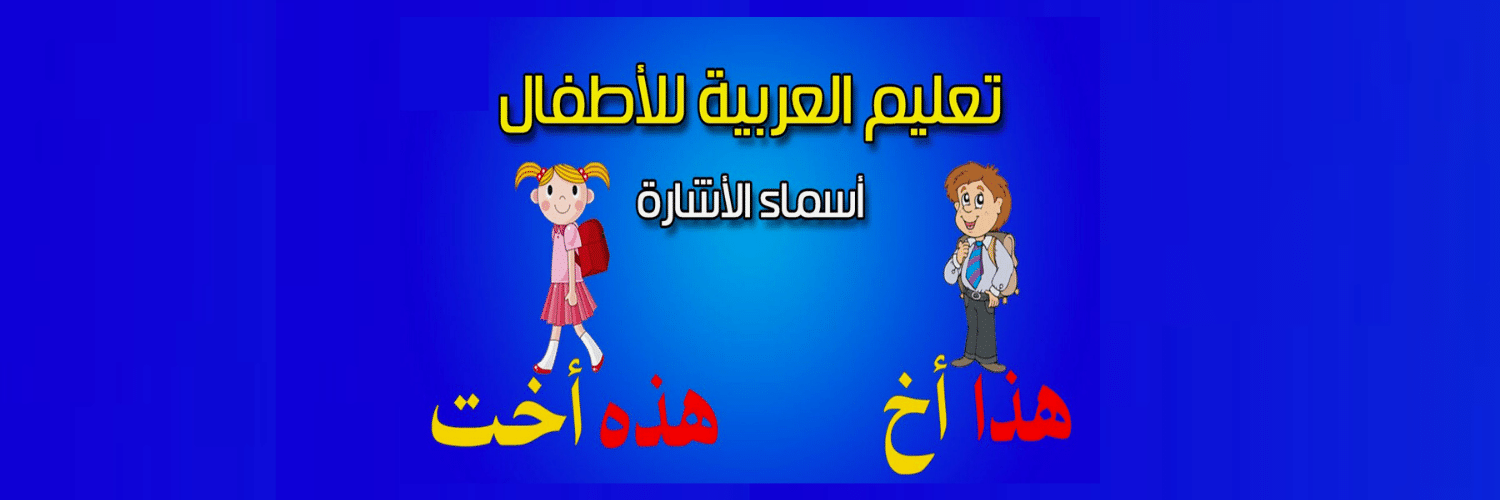The importance of teaching Arabic
Arabic language is of great importance as it is the language of the Noble Qur’an, the Prophet’s Sunnahﷺ, the language of the Islamic religious and cultural heritage, and one of the most important elements of the cultural and civilizational identity of Muslims owing to its expressive aesthetics and linguistic miracles. Therefore, a large number of Muslims and others are keen to learn it and teach it to their children, following the advice of the Messenger of God, ﷺ, who said: “Learn Arabic and teach it to people.”
The importance of teaching Arabic to children
Teaching Arabic to children is of special importance, as it is the language of the Qur’an that they must learn to understand , contemplate, apply what is contained in it on various aspects of life, and it is the child’s means of expression, communication and formation of experiences, and the beginning of his linguistic outcome.
Therefore, educators were interested in developing appropriate educational curricula to teach children Arabic smoothly and easily, curricula that reflect the theoretical and practical reality of applying the language in the child’s early stages, because education in childhood is like engraving on a stone.
To evaluate your true level in Arabic according to language standards, start now with placement tests based on scientific foundations by experts and language specialists at IQRA Network for teaching Arabic and the Holy Qur’an.
Arabic language curriculum for children
There are five important elements in the teaching and learning process: the curriculum, the teacher, the learner, the environment and the educational material, the most important of which is the educational curriculum due to its standards, controls, conditions and specifications. The three aspects of the curriculum that are the most important:
1-The psychological aspect
Among the psychological bases that must be taken into account: motives, trends, gender, age, intelligence, and individual differences.
2-The cultural and social aspect.
Understanding culture is part of learning the language. Attention must be paid to of the language, and the Arabic language Islamic and scientific trends in correcting concepts and presenting Arab culture through situations that demonstrate the Arabic-speaking community civilization.
3-Linguistic aspect
It is necessary to work on bringing the Arabic language closer to the child, renewing and developing it so that the child acquires it quickly, choosing words and vocabulary accurately, taking into account the accuracy, correctness and soundness of the linguistic information provided, and the Arabic language nature and characteristics.
So the curriculum should have these characteristics :
It contains various suspense-themed exercises to attract children.
– Verbal, audio and visual exercises to learn Arabic language skills.
– Includes the basics of the Arabic language and its skills.
– Diversification in the methods and adopting interactive and innovative presentation ways.
– The sequence in presenting the content from letters and words to structures and then sentences.
– It contains a set of good behaviors that reflect daily life.
– Keeping pace with technological development and using all educational technology means.
An overview of IQRA Network curricula
IQRA Network for Teaching the Noble Qur’an and Arabic Language Online provides distinguished educational curricula for teaching Arabic and Islamic studies for those who are eager to learn it and for non-native speakers. Our curricula are based on:
-Teaching the Arabic language,”the language of the Noble Qur’an”, using integrated modern educational means.
-Training students to use the Arabic language, both spoken and written.
– Integrating all the skills of learning the Arabic language,i.e. listening, speaking, reading, writing, and expression, through images, visual and audio clips, exercises and daily applications.
– Choosing a staff of expert and qualified teachers and academics to teach the Arabic language well.
-Providing a sound learning environment for students to continue learning faster and interactively.
-Providing a high-quality educational system, including scientific materials and comprehensive and integrated courses.
– Clarify and teach basic Islamic studies according to the Holy Quran and the Prophet’sﷺSunnah in Arabic.
-Supporting the memorization of the Noble Qur’an on sound foundations.
Methods and strategies for teaching Arabic to children
In the beginning, the teacher must have the correct pronunciation and clear letters’ exits so that the child can learn the correct pronunciation in his early stages.
Among the most important methods used in teaching Arabic to children:
1-Direct Indoctrination
Where the child hears letters and words and tries to imitate the sounds he hears, and the Quran memorization sessions are one of the most important examples of oral indoctrination for children.
2-Stories
Telling stories to the child has a great impact on his learning of the language, as it enriches the child’s linguistic inventory in a simple and conversational manner.
3-Songs and Chants
The songs facilitate memorizing and language learning processes for the child, as they leave beautiful feelings in the child, that help him to sing and enjoy Arabic language beauty and its good effect on his heart due to its words ease.
4-Memorization Courses
It is represented in literary prose and simple poetry full of meanings and aesthetic structures in a different rhetorical way.
5-Language Games and Activities
Games help children to practice language.
6-Dialogue and Role-playing
It helps the child to express himself using the Arabic language, structures and sentences with different meanings, and develops the child’s creativity.
Teaching the alphabet to children
Learning the alphabet is one of the most important steps in a child’s mental development, as it serves as the cornerstone for learning to read and write. Children’s interest in learning letters starts from an early age, some of them learn quickly and others need more time and repetition to be able to learn, pronounce and write letters properly. By reading, singing and playing games with children, you can arouse their desire and curiosity about the alphabet and to learn more.
The first phase in learning letters:
– Recognize letters.
– Read or chant the letters of the alphabet.
– Knowing the letters’exits and their pronunciation with the correct sound for each letter.
– Knowing of each letter shape and drawing.
– Writing letters correctly.
The second phase:
– After making sure that they are proficient in pronunciation and writing, they begin to teach them the letters ofMadd(extensionof vowels) and their composition, such as (ت، تا، تو، تي)
– Proficiency in pronunciation, composition and writing of all letters.
The third phase:
– Training the child on words containing the letters he learned and linking them to letters ofMadd((extension of vowels)) withحَرَكَاتHarakat (movements) such as ( تُوت، بَاب) and the word should not exceed three letters.
– Read the )( ألdefinition as one letter at the beginning of the word.
– Repetition and entering words more than three letters so that it is easier for the child to spell words quickly and easily.
All the previous stages are interspersed with various exercises and exercises for the child to acquire the Arabic language skills through interesting methods, i.e. the use of colors and images.
Share the video with us to learn about IQRA Network Teaching Methods and Strategies.
The importance of reading and writing skills in teaching Arabic to children
Reading Skill :
The skill of reading is one of the most important basics of learning the Arabic language for children because it is the verbal and auditory link to distinguish between words. To be able to know the relationship between letters and sounds.
To develop a child’s reading skill, there are several steps:
1-Phonemic perception
It is the child’s knowledge of the rhyme and rhythm of sounds in syllables and words, and increasing the child’s phonological awareness develops reading skill through educational songs.
2-Use word cards
Write words on cards and ask the child to read them, which helps him to pronounce the phonics properly and analyze the words.
3-Word games
Choosing simple words to encourage the child to listen, speak and recognize the sounds of words and letters, example (كتاب)
What sound does the word begin with? And what sound does it end with? Or use LEGO bricks to identify letters.
4-Take advantage of technology
Use technology and smartphones to turn fun time into fun learning by using educational websites to develop reading skill.
5-Motivate the child
Motivating the child and encouraging him to continue learning, reading through physical and moral reinforcement, and rewards.
6-Choosing books and stories
Searching for books and stories that suit the child’sinterests and tendencies ,i.e. thatare reinforced with pictures, colors and cartoon characters to attract the child.
7-Be patient
The reading process is a complex process, and the child may feel tired and bored shortly after the start of learning. Patience and a variety of activities are required to encourage the child and develop his reading skill.
8-The Noble Qur’an and memorization episodes
Reading the Qur’an helps to correct children’s pronunciation, and the correct letters’ exits according to the rules of Tajweedand sound recitation, which develops the child’s reading skill and language acquisition and learning.
9-Strengthening the language inventory
By talking about things outside the home and the limits of the child’s knowledge, to add new meanings, and to imitate animal sounds.
Writing Skill :
To teach the first steps of writing to children, attention must be paid to the child’s psychological and motor readiness and to ensure his ability to use the pen in the correct manner, and mastery of writing and drawing lines, then move to the stage of writing (letters – words – sentences) with continuous training to develop the child’s writing skill. Writing is a means of communication, self-expression, and recording of facts and events.
The importance of writing skill in teaching Arabic:
Muslims have been interested in writing and recording since the spread of Islam to preserve the linguistic heritage. Our Holy Prophet, ﷺ, was interested in teaching Muslims to read and write, so he made the sacrifice of a captive of theQuraysh infidels in the Battle of Badr , teach ten Muslim boys to read and write, and urged his companions(RA) to teach Muslim boys to write after the emigration to Medinah, to clarify the science and education status , its role in nations’ elevation and civilizations , its impact in spreading the call and the message and in support of the texts, verses and linguistic miracles of the Holy Qur’an.
Teaching writing passes through several stages, the most important of which are:
1-The stage of writing letters
So that the teacher makes sure that the child masters the letters of the alphabet in writing, pronunciation and understanding.
2-Copying stage
Transcription is the imitation of drawing and repetition to train the child and help him to spell correctly and reinforce what he has learned from vocabulary and structures.
3-Spelling stage
It is the stage of revealing the learner’s ability to write what he hears, distinguishing between linguistic sounds and training him on correct writing.
4-The stage of directed writing
Among the most important forms of this stage, which are carried out under the teachers’ supervision: writing parallel sentences, filling in the blanks in words, arranging words to form meaningful sentences and linking sentences.
5-The stage of free writing or composition and expression
It is considered the last stage of developing the writing skill, and it includes creative and narrative expression, writing reports and letters, and writing down information, and facts on a variety of linguistic bases and rules.
Last but not least, the Arabic language remains, a distinct language since it is the language of the Holy Qur’an and the Prophet’s ﷺ fragrant biography, a language that distinguishes Muslims around the world because of its beauty, sweetness and aesthetic innovations. The language of Dhad, which contains twenty-eight letters, each letter has a significance and linguistic miracle. Its words and vocabulary range from simplicity and ease to structure and complexity,the language of Islamic civilization and culture, it is the duty of every Muslim to learn his language and teach it to his children in order to raise a righteous generation that spreads its culture and language around the world, a generation that contemplates and reflects on the Noble Qur’an verses, savors its meanings and applies them to various aspects of life.
Learn More About : An Arabic Curriculum for Non-native Speakers at IQRA Network.
Not sure if the articleis relevant? Yes ( ) No ( )





1 Comment
Oops comments are disabled